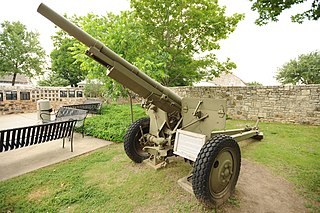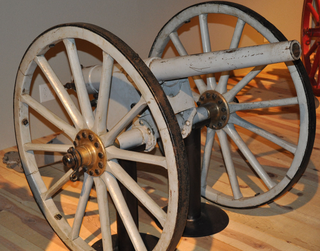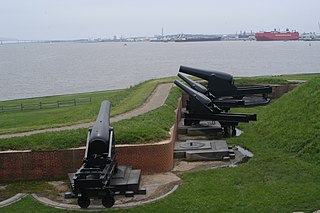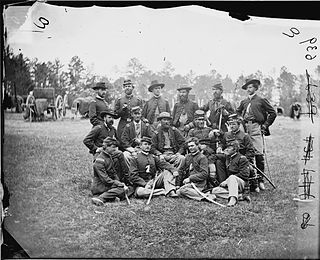 W
WThe QF 1 pounder, universally known as the pom-pom due to the sound of its discharge, was a 37 mm British autocannon, the first of its type in the world. It was used by several countries initially as an infantry gun and later as a light anti-aircraft gun.
 W
WThe 3-inch field gun M1902 (76.2 mm), a.k.a. M1904 and M1905, was the U.S. Army’s first nickel steel, quick-firing field gun with a recoil mechanism. Like its predecessor the 3.2-inch gun M1897, it was a rifled breechloader.
 W
WThe 3.2-inch gun M1897 (81 mm), with its predecessors the M1885 and M1890, was the U.S. Army's first steel, rifled, breech loading field gun. It was the Army's primary field artillery piece in the Spanish–American War, Philippine–American War, and Boxer Rebellion from 1898 to 1902.
 W
WThe 14-inch M1920 railway gun was the last model railway gun to be deployed by the United States Army. It was an upgrade of the US Navy 14"/50 caliber railway gun. Only four were deployed; two in the Harbor Defenses of Los Angeles and two in the Panama Canal Zone, where they could be shifted between the harbor defenses of Cristobal (Atlantic) or Balboa (Pacific).
 W
WThe 75 mm Field Gun M1897 on M2 Carriage was a field gun and anti-tank gun which was used by the US Army during the interwar period and World War II.
 W
WDriggs-Schroeder was the name of several naval guns designed by US Navy officers William H. Driggs and Seaton Schroeder for the United States Navy in the late 1880s, fitted on ships built in the 1890s. Some Driggs-Schroeder weapons were also adopted by the US Army. Driggs later founded the Driggs-Seabury Ordnance Company in 1897, in partnership with his brother Louis Labadie "L. L." Driggs and Samuel Seabury, a retired US Navy officer.
 W
WThe Field Artillery Branch is a combat arms branch of the United States Army.
 W
WThe Hotchkiss gun can refer to different products of the Hotchkiss arms company starting in the late 19th century. It usually refers to the 1.65-inch (42 mm) light mountain gun; there were also a navy (47 mm) and a 3-inch (76 mm) Hotchkiss guns. The 42 mm gun was intended to be mounted on a light carriage or packed on two mules to accompany a troop of cavalry or an army travelling in rough country.
 W
WThe 105 mm M101A1 howitzer is an artillery piece developed and used by the United States. It was the standard U.S. light field howitzer in World War II and saw action in both the European and Pacific theaters. Entering production in 1941, it quickly gained a reputation for accuracy and a powerful punch. The M101A1 fires 105 mm high explosive (HE) semi-fixed ammunition and has a range of 12,330 yards (11,270 m), making it suitable for supporting infantry.
 W
WThe M102 is a light, towable 105 mm howitzer used by the United States Army in the Vietnam War, the First Gulf War, and the Iraq War.
 W
WThe M119 howitzer is the US designation for the L118 light gun, a lightweight British 105 mm howitzer also used by the United States Army. It can be easily airlifted by helicopter, or dropped by parachute. It does not need a recoil pit.
 W
WThe M198 howitzer is a medium-sized, towed 155 mm artillery piece, developed for service with the United States Army and Marine Corps. It was commissioned to be a replacement for the WWII-era M114 155 mm howitzer. It was designed and prototyped at the Rock Island Arsenal in 1969 with firing tests beginning in 1970 and went into full production there in 1978. It entered service in 1979 and since then 1,600 units have been produced and put into operation.
 W
WThe M777 howitzer is a towed 155 mm artillery piece. It is used by the ground forces of Australia, Canada, India, Saudi Arabia, and the United States. It made its combat debut in the War in Afghanistan.
 W
WThe M1875 mountain gun was a mountain gun that was used by the United States Army during the last quarter of the nineteenth century.
 W
WThe M1918 240 mm howitzer was a copy of a French World War I siege howitzer, manufactured in the U.S. to specifications of the U.S. Army.
 W
WThe QF 2.95-inch mountain gun was the designation given by the British to a Vickers 75 mm calibre gun. It was originally produced for the Egyptian Army. It was taken into British service in the late 19th century to provide the 'movable armament' at some coaling stations. Also known as 'The Millimetre Gun', it was used by the West African Frontier Force in several theatres in Africa during World War I. It was also used by United States and Philippines.
 W
WThe Ordnance QF Hotchkiss 6 pounder gun Mk I and Mk II or QF 6 pounder 8 cwt were a family of long-lived light 57 mm naval guns introduced in 1885 to defend against new, small and fast vessels such as torpedo boats and later submarines. There were many variants produced, often under license which ranged in length from 40 to 58 calibers, but 40 caliber was the most common version.
 W
WSeacoast defense was a major concern for the United States from its independence until World War II. Before airplanes, many of America's enemies could only reach it from the sea, making coastal forts an economical alternative to standing armies or a large navy. After the 1940s, it was recognized that fixed fortifications were obsolete and ineffective against aircraft and missiles. However, in prior eras foreign fleets were a realistic threat, and substantial fortifications were built at key locations, especially protecting major harbors.
 W
WShip gun fire-control systems (GFCS) are analogue fire-control systems that were used aboard naval warships prior to modern electronic computerized systems, to control targeting of guns against surface ships, aircraft, and shore targets, with either optical or radar sighting. Most US ships that are destroyers or larger employed gun fire-control systems for 5-inch (127 mm) and larger guns, up to battleships, such as Iowa class.
 W
WThe Horse Artillery Brigade of the Army of the Potomac was a brigade of various batteries of horse artillery during the American Civil War.